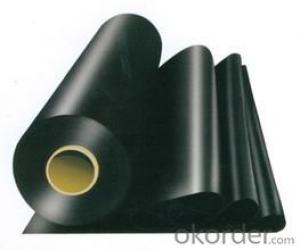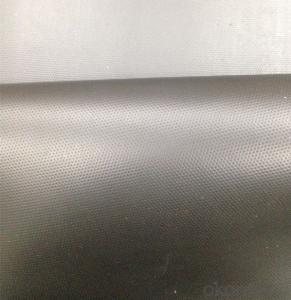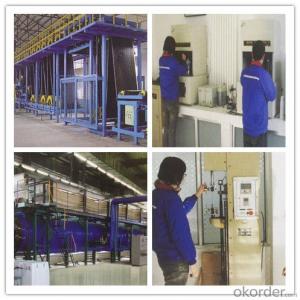EPDM Rubber Waterproof liner Good Elongation for roof
- Loading Port:
- Qingdao
- Payment Terms:
- TT OR LC
- Min Order Qty:
- 3500 m²
- Supply Capability:
- 250000 m²/month
OKorder Service Pledge
OKorder Financial Service
You Might Also Like
EPDM Rubber Waterproof Membrane
Product Instruction:
EPDM waterproof membrane is made from ternary ethylene-propylene rubber,which is designed for waterproofing of exposed and non-exposed applications. EPDM waterproof membrane is of high elasticity among high polymer waterproof materials and becomes a world-popular waterproofing material.
CNBM own the wold-advanced equipment of cold feeding extrusion and continuous vulcanization technology. With the best performance among high polymer waterproof materials, EPDM is of exceptional elasticity and will not split or cracked under normal building movement.
Product Features:
-Excellent weather-ability, durability and size stability
-Good adaptability to high and low temperature, UV resistant and anti-corrosion
-High tensile strength and good elongation, accommodating to structure movement
-Easy installation, solid joint, and mo environmental pollution
-Good rooting penetration resistance
-Service life up to 50 years
Applications:
-Roof, basement, tunnel, pond liner, dam
-Industrial and civil building waterproofing
-Geosynthetic liner for fish ponds, swimming pools, channels, irrigation system
-Especially suitable for projects with high requirement in durability, anti-corrosion and deformation
Specifications:
-Width of roll: 1.2m, 2m, 4m
-Length of roll: 20m, 30m or customized
-Thickness of membrane: 1.2mm, 1.5mm, 2mm
-Type: vulcanized EPDM or welding EPDM
-Application: roof, basement, pond, lake, swimming pool, steel structure roofing, underground, tunnel, etc
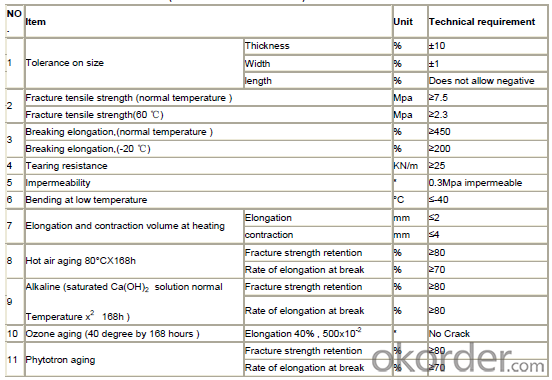
FAQ:
1. Is your EPDM waterproof membrane the real rubber?
Yes, our EPDM membrane is made from top quality rubber, which is imported from America. We support samples for testing, or testing in our factory.
2. How's your products quality?
Our EPDM is with the top quality at home and abroad. Our quality is much higher than Chinese standard. Our product is widely used in Chinese Central government projects. And it's also accpted by customers all over the world, such as EU, USA, Astrulia, etc.
3. What's the service life of your EPDM membrane?
The service life of our EPDM membrane is more than 50 years.
4.What's your MOQ?
Our MOQ is 3000M2.
5. What's your product ability of EPDM membrane?
We own the largest EPDM production line in China. Our product ability of EPDM membrane reaches 2 million square meter per year.
Photos:
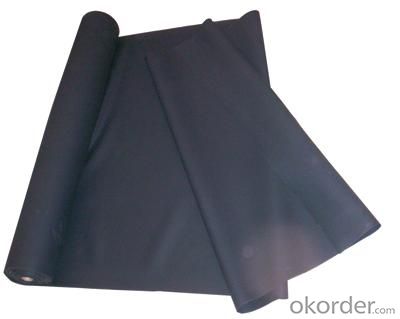
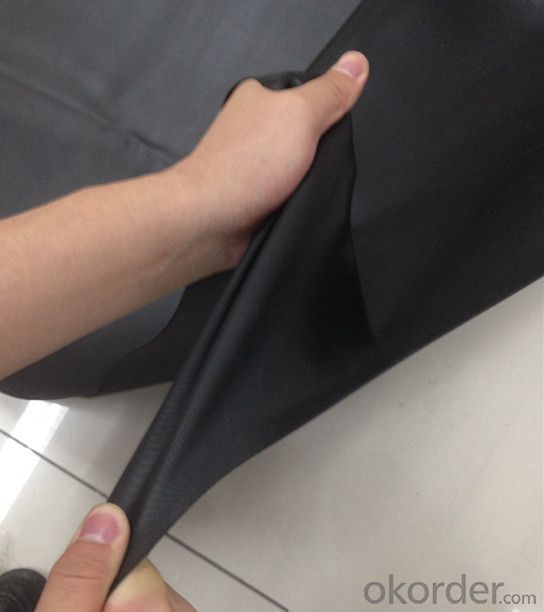



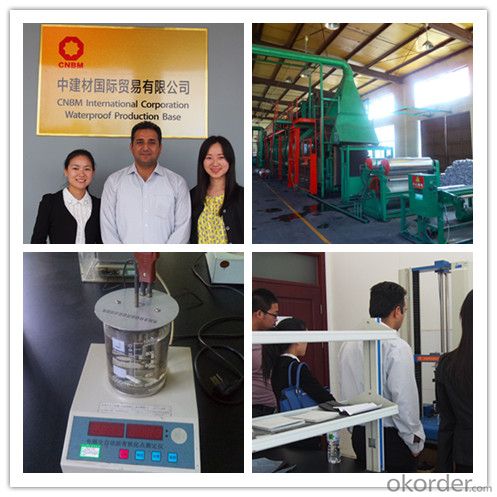
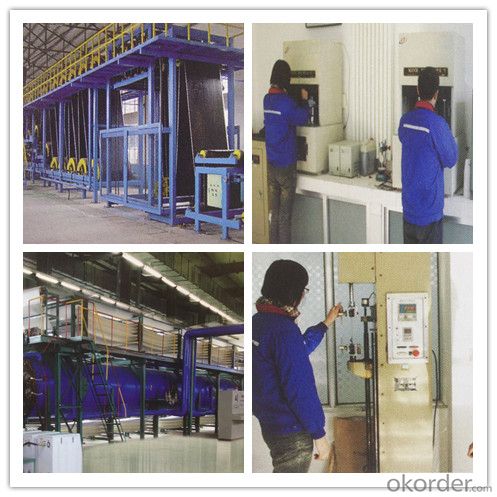
- Q:Can a waterproofing membrane be used in planter boxes or raised beds?
- Yes, a waterproofing membrane can be used in planter boxes or raised beds. It can help prevent water damage to the surrounding structures and extend the lifespan of the planter boxes or raised beds. However, it is important to ensure proper drainage to prevent water from pooling and causing root rot in the plants.
- Q:Are there any specific building code requirements for waterproofing membranes?
- Yes, there are specific building code requirements for waterproofing membranes. These requirements vary depending on the local building codes and regulations in each jurisdiction. However, in general, building codes typically outline the necessary standards for materials, installation methods, and performance criteria of waterproofing membranes to ensure effective protection against water infiltration in structures. It is important to consult and adhere to these codes to ensure compliance and maintain the durability and integrity of the building.
- Q:Can a waterproofing membrane be used for a parking garage?
- Indeed, a parking garage can benefit greatly from the utilization of a waterproofing membrane. Specifically designed to act as a barrier against water infiltration, this membrane effectively safeguards the underlying structure from potential moisture damage. Given the frequent exposure to water and moisture in parking garages due to rain, snow, and vehicle fluids, incorporating a waterproofing membrane is a vital aspect of the building envelope system. Its application on various concrete surfaces, such as the floor and walls, effectively prevents water seepage and subsequently hinders the occurrence of deterioration, corrosion, or any form of harm to the parking garage's structural integrity. Moreover, a waterproofing membrane also serves to mitigate the development of efflorescence, mold, and mildew, all of which are commonly found in damp environments. In conclusion, the implementation of a waterproofing membrane within a parking garage is an efficient approach to ensure the structure's long-term durability and functionality.
- Q:Can a waterproofing membrane be used for fire pit areas?
- Using a waterproofing membrane for fire pit areas is not recommended. Although waterproofing membranes are effective at preventing water penetration, they are not suitable for withstanding the intense temperatures and fire hazards typically found in fire pits. Specific fire-resistant materials are necessary for fire pit areas to withstand the heat and mitigate any potential fire accidents. To ensure safety and prevent damage, it is vital to use materials explicitly designed for fire pit areas.
- Q:Can a waterproofing membrane be used on tunnels with seismic protection systems?
- Yes, a waterproofing membrane can be used on tunnels with seismic protection systems. In fact, it is highly recommended to use a waterproofing membrane in such tunnels to prevent water ingress and subsequent damage to the structure. Seismic protection systems are designed to absorb and dissipate the energy generated by an earthquake, ensuring the safety and stability of the tunnel. However, these systems do not provide any protection against water infiltration. By installing a waterproofing membrane, the tunnel can be safeguarded against potential water leaks and seepage, which can lead to corrosion of reinforcement, deterioration of concrete, and overall structural damage. It is important to select a waterproofing membrane specifically designed for use in tunnels, considering factors such as flexibility, durability, and resistance to movement caused by seismic events. Additionally, proper detailing and installation techniques should be employed to ensure a seamless and effective waterproofing system that works in conjunction with the tunnel's seismic protection measures.
- Q:Are waterproofing membranes resistant to efflorescence?
- Yes, waterproofing membranes are typically resistant to efflorescence. Efflorescence is the crystalline deposit of salts that can occur on the surface of materials like concrete or masonry when moisture migrates through them. Since waterproofing membranes create a barrier against moisture, they prevent the migration of water and consequently minimize the occurrence of efflorescence.
- Q:Can a waterproofing membrane be used in conjunction with energy-efficient building designs?
- Yes, a waterproofing membrane can be used in conjunction with energy-efficient building designs. In fact, incorporating a waterproofing membrane into the construction of an energy-efficient building can provide several benefits. Firstly, a waterproofing membrane helps to protect the building envelope from water infiltration, which is critical for maintaining the integrity and longevity of the structure. By preventing water damage, the building can avoid costly repairs and potential energy losses caused by moisture intrusion. Additionally, a well-designed waterproofing system can contribute to the energy efficiency of the building by reducing the need for mechanical heating and cooling. By preventing moisture from entering the building envelope, the waterproofing membrane helps to maintain a consistent indoor temperature, reducing the load on HVAC systems and improving energy efficiency. Furthermore, certain types of waterproofing membranes, such as those with reflective or heat-resistant properties, can also contribute to energy savings by reducing heat transfer through the building envelope. These membranes reflect solar radiation, reducing the amount of heat absorbed by the building, and thus decreasing the demand for cooling. Lastly, waterproofing membranes can be integrated with other energy-efficient building components, such as green roofs or rainwater harvesting systems. These systems can help to further reduce energy consumption by providing insulation, reducing stormwater runoff, and promoting sustainable water management practices. Overall, incorporating a waterproofing membrane into an energy-efficient building design can enhance both the durability and energy performance of the structure. It offers protection against water damage, reduces the load on mechanical systems, and can be integrated with other sustainable features, making it a valuable component of energy-efficient building designs.
- Q:Can a waterproofing membrane be used on roofs with flat surfaces?
- Yes, a waterproofing membrane can be used on roofs with flat surfaces. In fact, waterproofing membranes are commonly used on flat roofs to provide protection against water infiltration. These membranes are designed to create a barrier that prevents water from seeping into the roof structure and causing damage. They are typically made of materials such as modified bitumen, EPDM, or PVC, which are highly resistant to water and UV rays. The membrane is installed over the roof surface and can be either torch-applied, adhered with adhesive, or mechanically fastened. It is important to ensure proper installation and regular maintenance to maximize the effectiveness and lifespan of the waterproofing membrane on a flat roof.
- Q:Can a waterproofing membrane be used on iron surfaces?
- Yes, a waterproofing membrane can be used on iron surfaces. The membrane will provide a protective barrier against water penetration, helping to prevent corrosion and damage to the iron surface.
- Q:Can a waterproofing membrane be used in conjunction with sustainable construction materials?
- Yes, a waterproofing membrane can be used in conjunction with sustainable construction materials. In fact, incorporating sustainable construction materials is increasingly becoming a priority in the construction industry due to the need for more environmentally friendly and energy-efficient buildings. Waterproofing membranes can be used to protect sustainable construction materials, such as recycled or low-impact materials, from water damage and moisture infiltration. These membranes create a barrier that prevents water from seeping through the materials, thus prolonging their lifespan and reducing the need for repair or replacement. Additionally, sustainable construction materials are often designed to be more energy-efficient, which can be further enhanced by using a waterproofing membrane. By preventing water damage, the membrane helps maintain the integrity of the building envelope, reducing the potential for energy loss through leaks or moisture intrusion. Moreover, some waterproofing membranes are specifically designed to be more sustainable themselves. For instance, there are eco-friendly membranes made from recycled materials or those that can be recycled at the end of their lifespan. These sustainable membranes minimize the environmental impact associated with their production and disposal. Overall, utilizing a waterproofing membrane in conjunction with sustainable construction materials is a smart and responsible approach to building design. It ensures the long-term durability and performance of the materials, while also contributing to a more sustainable and energy-efficient built environment.
1. Manufacturer Overview |
|
|---|---|
| Location | |
| Year Established | |
| Annual Output Value | |
| Main Markets | |
| Company Certifications | |
2. Manufacturer Certificates |
|
|---|---|
| a) Certification Name | |
| Range | |
| Reference | |
| Validity Period | |
3. Manufacturer Capability |
|
|---|---|
| a)Trade Capacity | |
| Nearest Port | |
| Export Percentage | |
| No.of Employees in Trade Department | |
| Language Spoken: | |
| b)Factory Information | |
| Factory Size: | |
| No. of Production Lines | |
| Contract Manufacturing | |
| Product Price Range | |
Send your message to us
EPDM Rubber Waterproof liner Good Elongation for roof
- Loading Port:
- Qingdao
- Payment Terms:
- TT OR LC
- Min Order Qty:
- 3500 m²
- Supply Capability:
- 250000 m²/month
OKorder Service Pledge
OKorder Financial Service
Similar products
New products
Hot products
Related keywords

